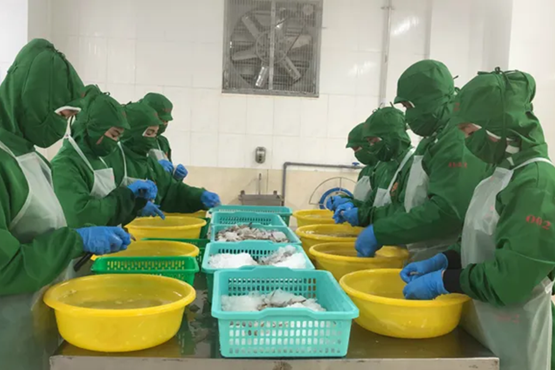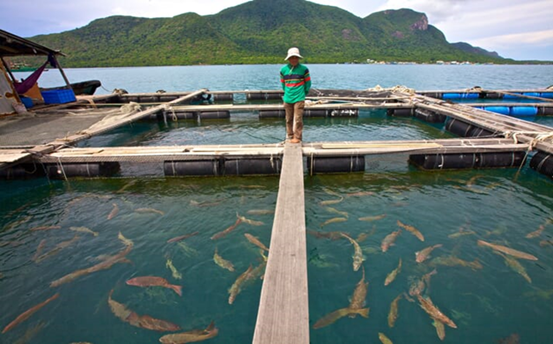How IDH’s 5-steps ensure living wages in Vietnam’s aquaculture sector
For three years, IDH is working to promote sustainable aquaculture through strengthening public private collaboration in the Mekong Delta in Vietnam. This resulted in more sustainable resource use and a reduction of antibiotics, an online platform for sharing information on disease and environmental data, and web-based traceability systems for the shrimp and pangasius value chains.
The project helped to improve the sustainability of the production of 630,000 tonnes of shrimp, tilapia and pangasius. Now it is time to also focus on living wages in the sector. While seafood companies want to address living wages, they seldomly act on it. Is this because companies find it too complex and difficult to know wages in their supply chains? After years of working on living wages in different sectors, IDH has developed a 5-step roadmap that can help to secure living wages.

The meaning of living wage
Earning a living wage means workers receive sufficient wages to afford a decent standard of living for the worker and their family. Elements of a decent standard of living include food, water, housing, education, health care, transportation, clothing and other essential needs – including provision for unexpected events. A living wage takes into account the difference between net and gross pay, so employees are sure to take home a sufficient amount to cover for those expenses.
What is the difference between a living wage and a minimum wage? Minimum wages are prescribed wage levels that are mandatory by local or national law. In some cases, they are sector specific. Minimum wages are set by governments and often reflect the supply and demand of labor—balancing needs of employers and employees.
“ Earning a living wage means receiving sufficient wages to afford a decent standard of
living for the worker and their family”

Step 1: Understand the living wage (LW) in Vietnam
The wages in Vietnam vary from region to region. The first step is to identify the living wage in your region of interest. There are different living wage benchmark methodologies. Each one has its own approach for calculating the living wage. To ensure a methodology is rigorous and consistent, IDH has developed a process to recognize living wage benchmark methodologies that meet nine criteria for quality.
Step 2: Understand what the LW gap is by using IDH’s salary matrix
Next is to evaluate how the total remuneration received by your employees (including wages, bonuses and in-kind benefits) compares to the relevant living wage benchmark for your region using the IDH Salary Matrix. This tool supports supply chain efforts on wage transparency, is publicly available and can be used by producers to understand their situation in terms of wages. Data inserted in the tool are not shared with anyone unless the user approves. Originally the Salary Matrix only addressed primary production, but IDH is extending it to manufacturing and are piloting it in the seafood sector in Vietnam. In the Ca Mau and Kien Giang provinces, IDH plans to work with five seafood processing plants to understand the difference between the current remuneration of workers and the living wage benchmark in the region. In the coming months, the processing plants will roll out the Salary Matrix to better understand their situation.
Step 3: Verification
The third step to address living wages in your supply chain is to verify calculations of living wage gaps. IDH has developed guidelines for verifying living wage gaps (preferably through third-party auditing) and a corresponding base report, which serves as the physical evidence for third-party verification of living wage gaps. Guidelines have also been developed for first- and second-party auditors. These guidelines have been developed to support schemes and auditing bodies interested in verifying living wage gaps.
Through a partnership with the Impact Buying Academy there is a training program for trainers of auditors and directly to auditors who want to assist companies in the verification of living wage gaps. The program is based on the guidelines for verifying living wage gaps and the proper use of the Salary Matrix to support living wage auditing. IDH thinks it would be beneficial for aquaculture certification schemes to also be trained, so that the industry can hopefully soon rely on verified data when it comes to LW gaps. Consequently, they will be able to validate the pilot results in Ca Mau and Kien Giang.

Step 4: Close living wage gaps
Any living wage gaps need to be addressed along the entire value chain. Through constant identification of the best practices within the sector. IDH can support seafood companies with recommendations on how to close the living wage gaps.
IDH partnered with the Vietnam General Confederation of Labour and CNV International in a pilot project on multi-company collective bargaining agreements (MCCBAs) in the seafood processing industry in Ca Mau and Kien Giang provinces. At present, eight seafood companies have been encouraged to pilot the approach and proposed practices for closing living wage gaps. Increasing wages, in-kind benefits and improving working conditions are also key topics in relevant social dialogues and core contents of the MCCBAs signed in other sectors in Vietnam.
Step 5: Share lessons
IDH believes the complex concept of living wages can be tackled by seafood companies in these steps, with the last step being to share lessons and insights with peers. Such lessons can benefit a larger audience, just as the seafood sector benefits from the lessons we learned in other sectors. IDH eager to share our knowledge of securing living wages for workers in the seafood sector.
Find full article on: Five steps to ensure living wages in Vietnam’s aquaculture sector |The Fish Site
For more information on living wage: https://www.idhsustainabletrade.com/living-wage-platform
Do you have any questions? Please send an email to han-lnv@minbuza.nl. We give regular updates on developments in the agriculture sector in Vietnam on this website and on our Twitter @AgroVietnam